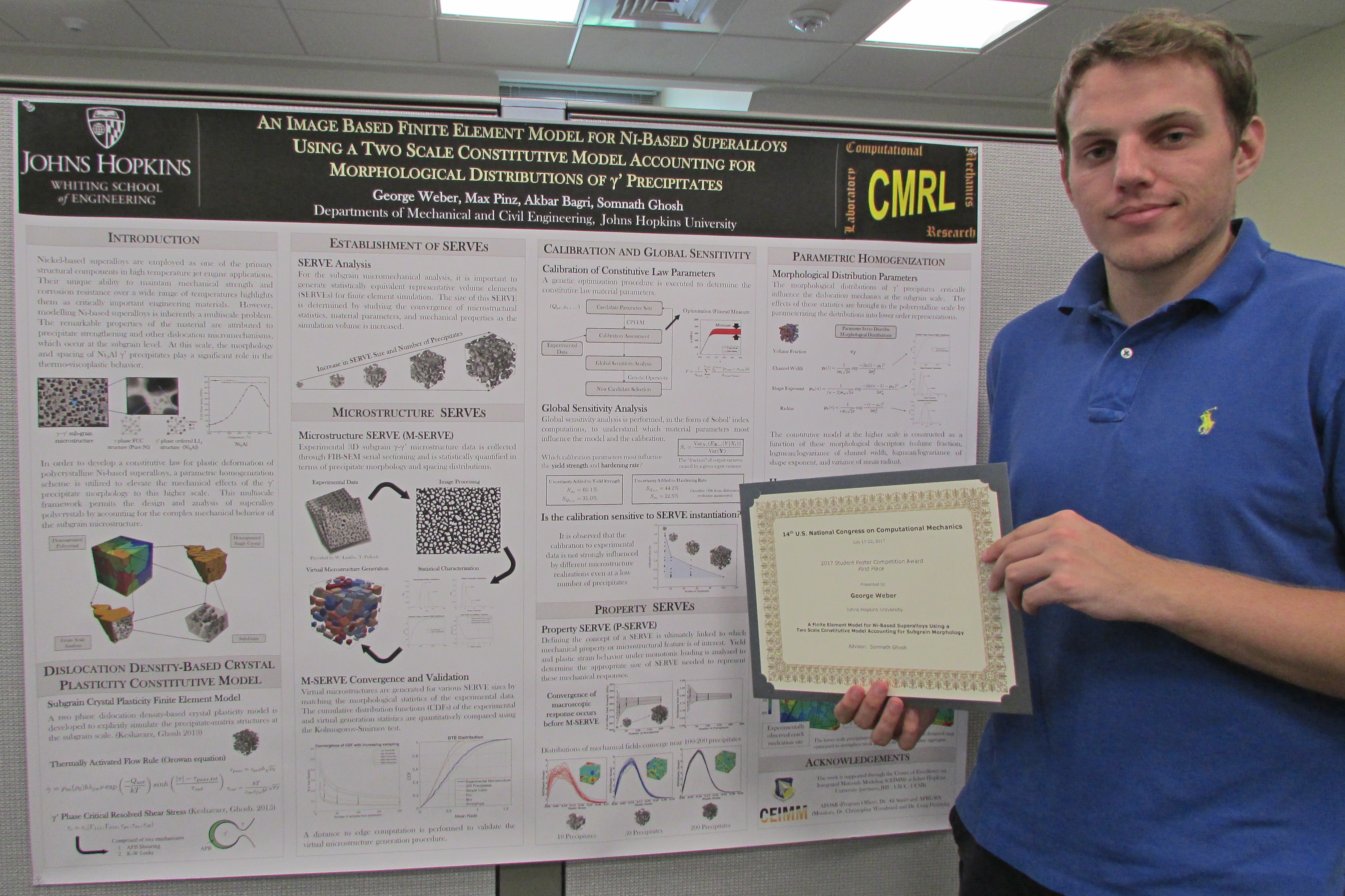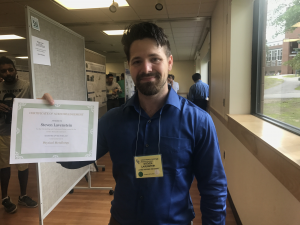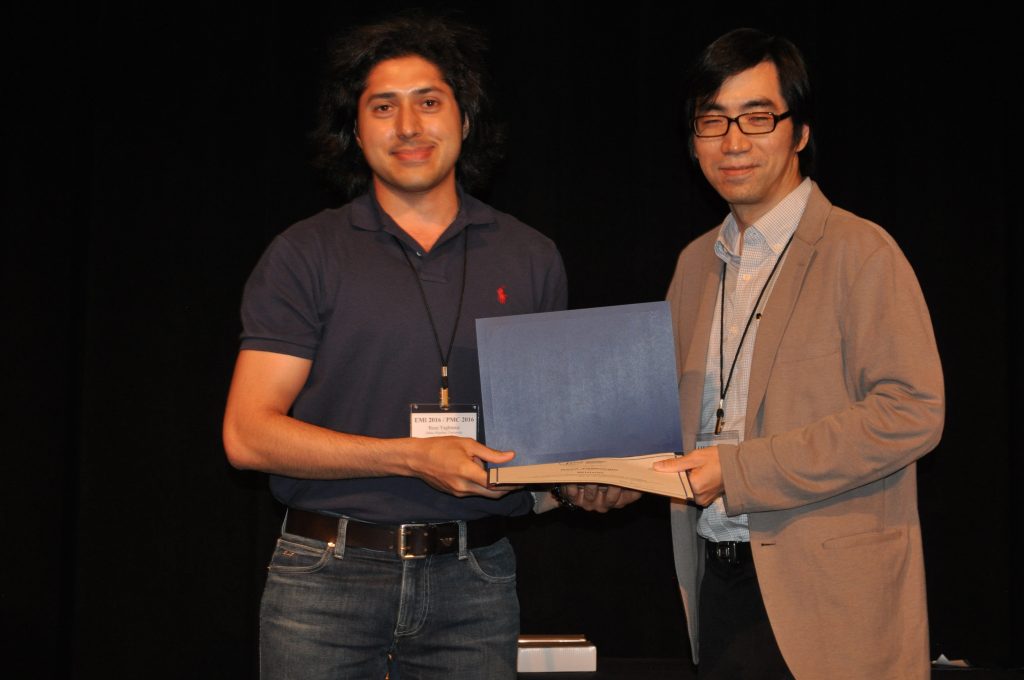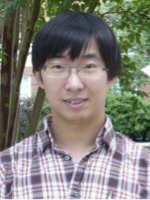The “CISMMS Workshop for Collaboration and Exploration”, co-sponsored by MARCC (The Maryland Advanced Research Computing Center) was held on December 12 2018 at Johns Hopkins University Homewood Campus.
The event began with the keynote lectures (Session Chair: Dr. Somnath Ghosh) by Dr. Raju Namburu (Chief Scientist, Laboratory Information Technology Lab, Engineering Research and Development Center, US Army) on “Computational Sciences Research Directions for DoD Applications”, followed by Dr. James Warren (Director Materials Genome Initiative, NIST) on The “Materials Genome Initiative and Artificial Intelligence”. Faculty and students from Johns Hopkins University and the University of Maryland gave talks and presentations on topics ranging from Numerical Modeling and Simulations to Use of novel methods like Machine Learning to accelerate Materials Research (Session Chairs: Jaime Combariza and Jamie Guest). The workshop concluded with a Poster Session and a discussion on research readiness and collaborations.
Details of the keynote talks and presentations
Keynote Talks (Session Chair: Somnath Ghosh)
Dr. Raju Namburu, Chief Scientist, Laboratory Information Technology Lab, Engineering Research and Development Center, US Army Title: Computational Sciences Research Directions for DoD Applications
Abstract: The Department of Defense (DoD) relies upon the science and technology to research, develop, and demonstrate critical technology solutions to the challenging problems faced by our Warfighters in multi-domain battlefield. Recently, Under Secretary of Defense for Research and Engineering released DoD’s top technology focus areas from 2018 National Defense Strategy. The U.S. Army Modernization Strategy addresses the challenges of the future operational environment and directly supports the 2018 National Defense Strategy’s (NDS) line of effort, and bulk of Army investments over the next five years are slated to support its modernization priorities. To accelerate modernization, development of modeling and simulation tools across Services including data analytics is common theme along these technology and modernization focus areas. This talk will highlight some of the trends in computational sciences research and collaboration opportunities to support DoD’s and Army’s emerging challenges.
Bio sketch: Dr. Namburu is the Chief Scientist for Information Technology Laboratory at the US Army Engineering Research and Development Center. Dr. Namburu is the chief architect in developing computational sciences strategy for the Army Research Laboratory, RDECOM, and DoD HPC Modernization program Dr. Namburu is instrumental in developing and establishing multi-service new computational sciences research programs in blast-structure interactions, multi-scale materials, tactical computing, low power computing, data mining, and mobile network modeling for the Army and DoD. As program manager, Dr, Namburu directed and guided one of the Army’s premier multi-million dollar Army High Performance Computing Research Center (AHPCRC) for the Department of Army over the last 15 years. Dr. Namburu is the founding Director for DoD Mobile Network Modeling and is instrumental in transitioning software and technologies to various DoD programs including test and evaluation command. Dr. Namburu is working group lead for information systems technology under DoD C4I community of interest and actively involved in developing various activities with OSD under DoD AI strategy. Dr. Namburu obtained his PhD in mechanical engineering from University of Minnesota. Dr. Namburu has more than 100 publications in various journals and refereed papers in international conferences and symposiums in the areas of computational sciences, computational mechanics, scalable algorithms, network modeling and high performance computing. His awards include the Department of the Army Superior Civil Service Award; Army Research Development and Achievement Award 1997, 2001, 2009; and the Army Science best paper awards at the 1998, 2000, and 2002 Army Science Conference. Dr. Namburu is a Fellow of American Society of Mechanical Engineers (ASME) as well as a member of USACM, and IACM.
Dr. James A. Warren, Director Materials Genome Initiative, NIST Title: The MGI and Artificial Intelligence
Abstract: The US Materials Genome Initiative is now seven years old. With a goal of accelerating the discovery, design, development, and deployment of new materials into manufactured products, the MGI is focused on the creation of a materials innovation infrastructure. My institution, the National Institute of Standards and Technology (NIST), has framed its support for the MGI around the need for a data infrastructure that enables the rapid discovery of existing data and models, the tools to assess and improve the quality of those data, and finally the development of new methods and metrologies based on that data. In partnership with agencies across the government, academia, and industry, these approaches are now yielding significant advances. Of particular note is the potential for machine learning and artificial intelligence applications upon these troves of data, which is now being borne out, and the vast consequent opportunities for new discoveries.
Bio Sketch: Dr. Jim Warren is a world leader in Materials Genome Initiative, a multi-agency initiative designed to create a new era of policy, resources, and infrastructure that support U.S. institutions in the effort to discover, manufacture, and deploy advanced materials twice as fast, at a fraction of the cost. In his role as Technical Program Director for Materials Genomics, he works with a government-wide team to build out the materials innovation infrastructure needed to realize the goals of the initiative. His research is broadly concerned with developing both models of materials phenomena, and the tools to enable the solution of these models. Specific foci include solidification, pattern formation, grain structures, wetting, diffusion, and spreading in metals. Dr. Warren got his Ph.D. in physics at the University of California, Santa Barbara and has been at NIST since 1992 in the Metallurgy Division and its successor the Materials Science and Engineering Division, within the Material Measurement Laboratory. He is also one of the co-founders, and the current Director, of the NIST Center for Theoretical and Computational Materials Science. In 2010 he helped craft the white paper that launched the Materials Genome Initiative, and since then has been coordinating the national effort while managing the program. Jim has 2nd-degree black belt in Taekwondo, as well as a lot of experience in improvisational theater, and has appeared on stage with very famous jugglers.
Presentations by CISMMS affiliated faculty (Session Chairs: Jaime Combariza and Jamie Guest)
Tim Mueller (MSE),The effective use of data in materials research
Poster: Dr. Liang Cao: The Use of Cluster Expansions to Predict the Structures and Properties of Nanostructured Alloys
Stavros Gaitanaros (CE), Mechanics of Architected Materials
Paulette Clancy (ChemBE), Electronic Materials Discovery and Processing: Algorithm and Code Base Development
Poster: Dr. Henry Herbol: The Physical Analytics pipeline: Bayesian Accelerated Materials Discovery
Mark Robbins (Physics), Friction and fracture from atomic to macroscopic scales
Poster: Dr. Joseph Monti: Dynamic Greens function method
Thomas Gernay (CE), Computational modeling of civil engineering structures at elevated temperature
Poster: Xia Yan and Dr. Shuna Ni: Numerical modeling of steel and concrete structures in fire
Ramani Duraiswami (University of Maryland Computer Science), Fast Multipole Methods (FMM) for Scalable Computational Physics
Nail Gumerov, (University of Maryland Computer Science), Applications of the FMM to problems in Multiphase Flow, Materials Science and Electromagnetics
Mauro Maggioni (AMS) 3 Samples of Statistical Learning for Dynamical Systems in High-Dimensions: Reaction Coordinates, SDE’s on Manifolds, And Particle Systems
Poster: Dr. M. Zhong: Learning Interaction Laws in Heterogeneous Agents Dynamics
Jamie Guest (CE) Topology Optimization Algorithms for High-Resolution Design
Poster: Mr. Misha Osanov: Advanced Engineering Design with Topology Optimization: Coupling Optimization, Mechanics, and Manufacturing to Generate High Performance Design Solutions
Gretar Tryggvason (ME), Numerical Simulations of Fused Filament Fabrication
Poster: Dr. Jiacai Lu: Computations of Complex Multiphase Flows
Rajat Mittal (ME), Cartesian Grid Immersed Boundary Methods for Complex Multiphysics Simulations
Poster: Dr. Jung Hee Seo: Cartesian Grid Immersed Boundary Methods for Complex Multiphysics Simulations
Yannis Kevrekidis (AMS), Reconciling Measurements across Several Sensors: Data Fusion and Nonlinear Observers for Complex Reaction Networks
Poster: Machine Learning for Better Data-Driven Prediction and Optimization of Cell Culture Bioprocess Performance
Michael Shields (CE), Machine learning and reduced order modeling for uncertainty quantification in materials applications and their integration in the new open-source Python UQ toolbox UQpy
Poster: Dr. Dimitris Giovanis: Machine learning and reduced order modeling
Somnath Ghosh (CE), Spatio-Temporal Multi-scale Multi-physics Modeling for Materials, Manufacturing and Multifunctional Applications
Poster: Mr. George Weber and Deniz Ozturk: Four classes of problem domains in Computational Mechanics Research Laboratory (CMRL)
Jaime Combariza MARCC, Advanced Computing Driving Transformative Research at Johns Hopkins University
Poster: Mr. Kevin Manalo: Data Intensive Scientific COmputing (DISCO) Certificate Program
Jaafar El-Awady group Poster: Dr. Yejun Gu: Machine learning and coarse grained simulations of materials









